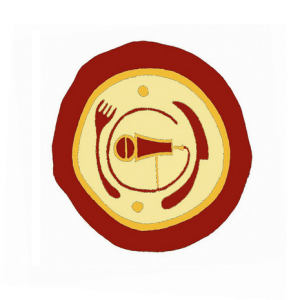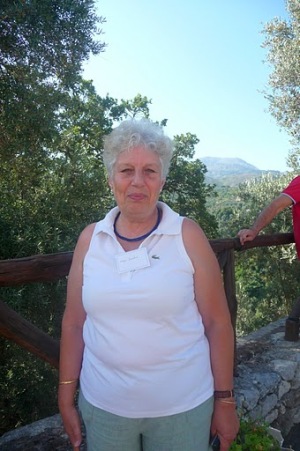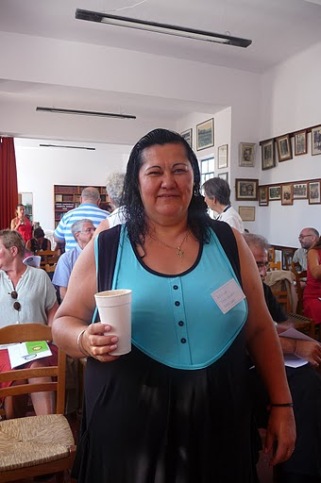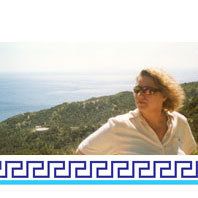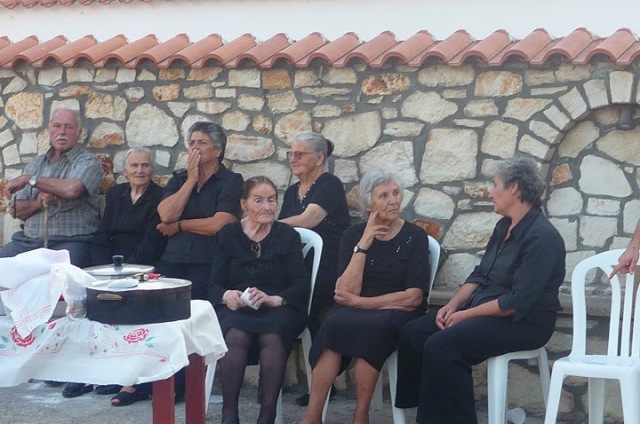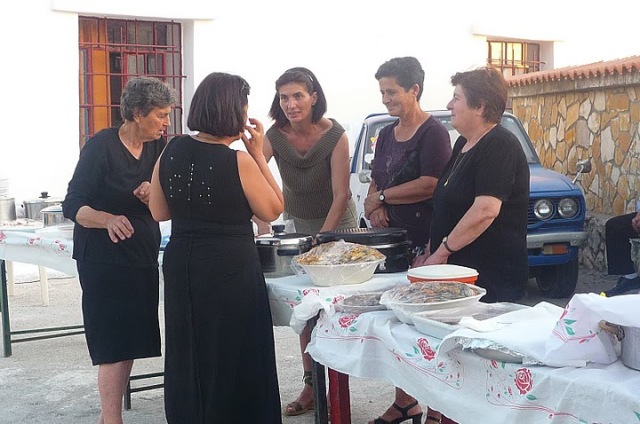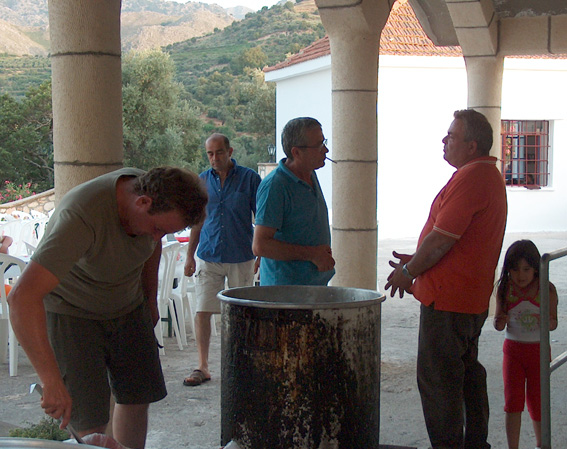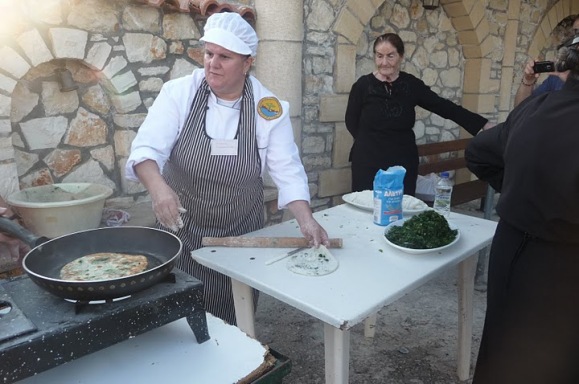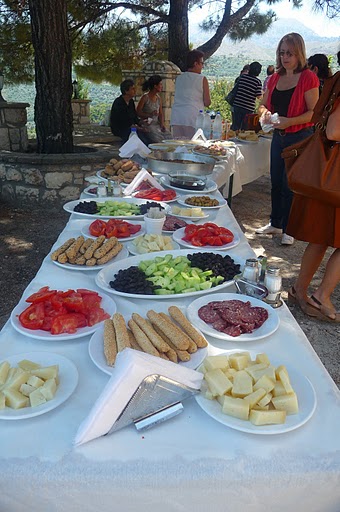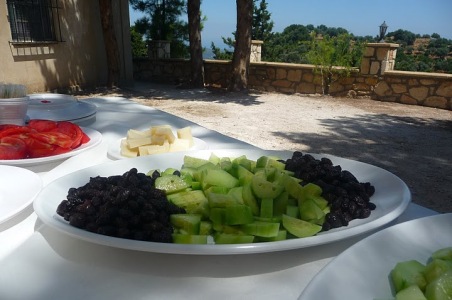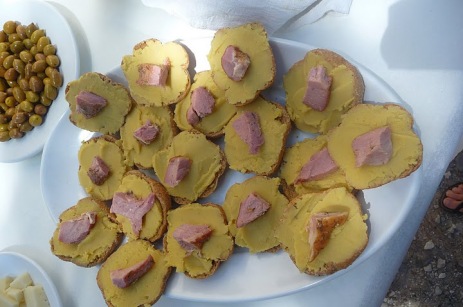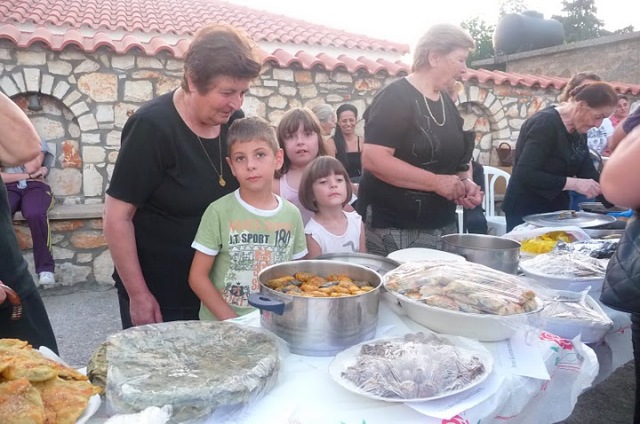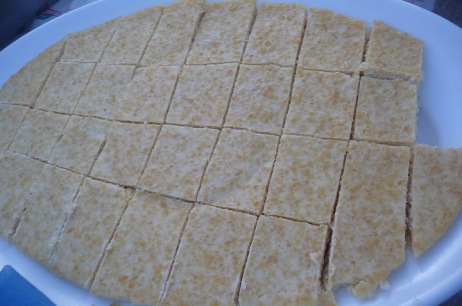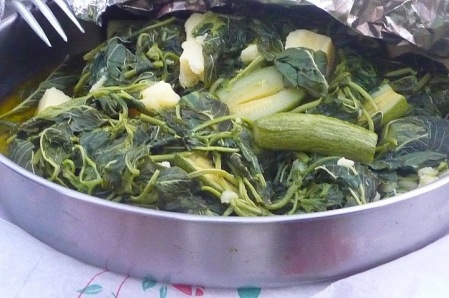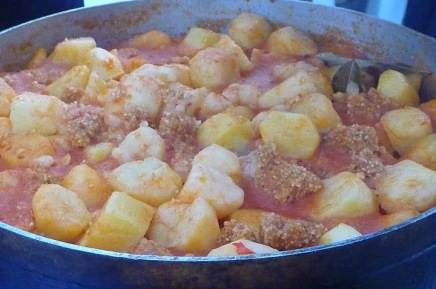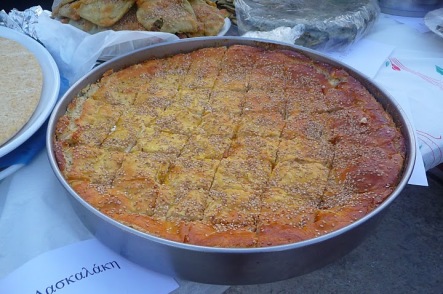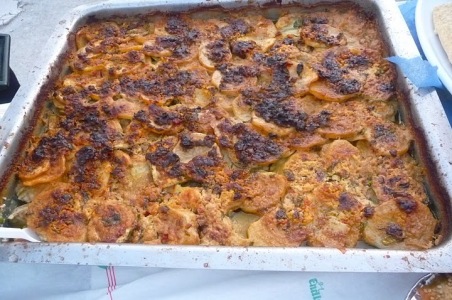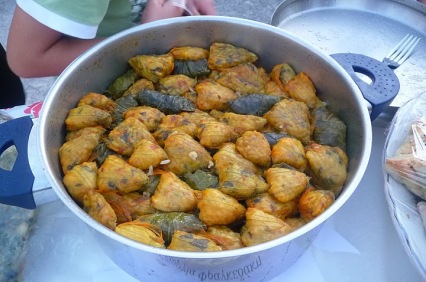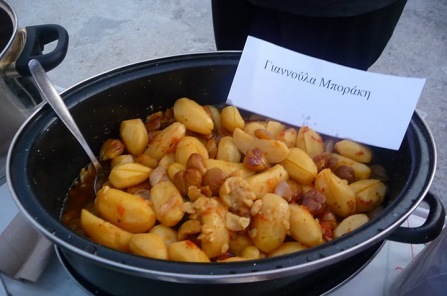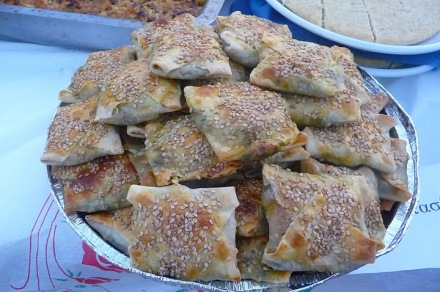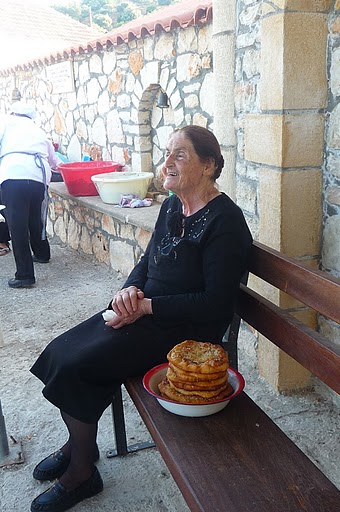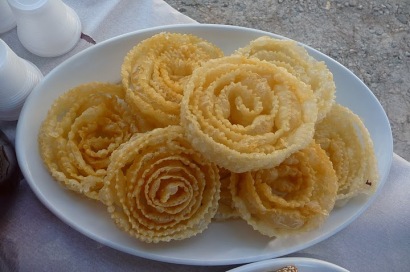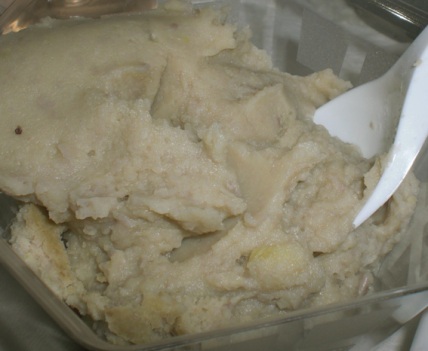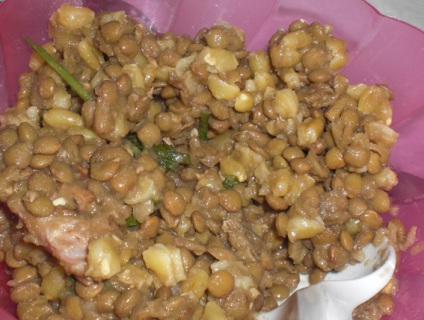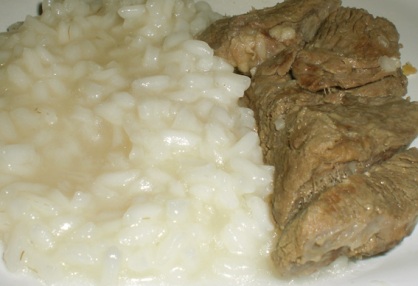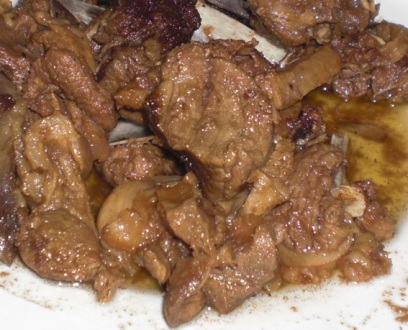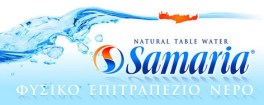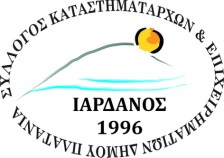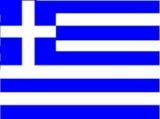1st SYMPOSIUM OF GREEK GASTRONOMY
Cretan cuisine: History, Evolution, Questions & Answers (?)
July 16-17, 2011
Κaranou
Organizers
Μariana Kavroulaki (Researcher into Greek Food History)
&
Historical, Folklore & Archaeological Society of Crete
ABSTRACTS
The importance, for archaeology, to study the fauna and the flora on excavations in Greece in order to address a more complete study of ancient diets.
Anaya Sarpaki, Dr. Archaeologist / Archaeobotanist & Melpo Skoula Dr. Βiologist/ Botanist, Park for the Preservation of Flora and Fauna at the TUC
It is important, and a sine qua non, to study the archaeology of the fauna and the flora (zooarchaeology and archaeobotany) in Greek excavations, for a study of ancient foods and food traditions.
An overview, will be presented, of what the archaeologists of the 20th century based their theory and ideology on, when studying everyday life and, specifically, when focusing on the study of food. This approach has obviously changed and has effected changes in the methodology and study of the basic data.
There is a need to understand that all the theory (e.x. questions, premises etc.) and the methodology which governs archaeological excavations, affects, to a very important degree, the possibilities, which, subsequently, the data itself permits to be unfolded by the researcher/archaeologist. Based on these ecofacts, the archaeologist could then venture into the study of food and an understanding of everyday life.
Nowadays, archaeology is becoming more interested in the study of ancient diets, but how is the problem addressed? This is a very important venture which touches upon archaeological, anthropological, sociological, religious areas of research and confronts us with several grey areas. Are we capable of reaching the depth of the spectrum of information that is incorporated in the study of diet? Or are we rather contented in just enumerating the possible diet and referring to some personal hypotheses, which is then manipulated in a journalistic manner, in order to provoke some sensations or even promote some scientist/laboratory? This relation between the data and the information will be discussed as these relate to the hypotheses and their ‘soundness’ about building models concerning ancient diet.
Tastes from seeds in prehistoric Greece: seeking continuities and discontinuities in archaeo-botanical data.
Sultana Maria Valamoti , Αrchaeologist /Assistant Professor, AUTH
Αrchaeobotanical research on prehistoric settlements in Greece in the last two decades has revealed a wealth of knowledge about the types of plants used by local residents during the Neolithic period (7th millennium BC – 3500 BC) and Bronze Age (3500 BC-1100 BC). A variety of wheat and barley species, pulses such as lentils, grass pea, pea and bitter vetch, fruits and nuts such as acorns, blackberries, grapes, Cornelian cherries and figs compose a rich list of ingredients in the prehistoric kitchen which, during the Bronze Age, was enhanced with more items originating in the North and East. In some cases, the archaeological deposits contained residues referring to specific preparations, such as grape juice and crushed cereal. These specific findings could refer to grape must, molasses, wine, bulgur and trachanas.
Through the exploration of archaeobotanical material, ie charred seeds found in archaeological deposits, an attempt is made to approach the plant components of prehistoric diet in Greece. This archaeobotanical investigation reveals species that continue to be grown, processed and consumed by modern-day residents of the area, as well as species that are no longer used or are making a comeback into the modern diet because of their beneficial nutritional characteristics.
“Lucullian meals” depicted in the mosaics of ancient Kissamos.
Stavroula Markoulaki, Ph.D student, Αrchaeologist
Among the mosaic floors that have come to light during excavations of ancient Kissamos, some of the more distinct are those that show, in a very naturalistic way, edible species of animal and plant origins. These mosaics decorated, as was to be expected, symposia rooms. The wealth of food implied by them, and the way they are depicted, sometimes as still life and other times as Xenia (a kind of hospitality), in the environment of the symposium, is an indication of the generosity of the host and a demonstration of his social status. At the same time however, to us, these depictions become a valuable information resource concerning the human diet in the then consolidated world of the Roman Empire, as well as the local peculiarities of Crete.
Edible Wild weeds in Venetian Crete (Poster).
Kyriaki Panteli, Social Geographer
The aim of this study is to show the diversity of edible weeds in the area of Crete and their uses in the daily diet during the years of Venetian rule (1211-1669). The survey was of a secondary nature, ie based on scientific publications (articles in journals, books and conference proceedings) and written testimonies of the time (Monk Agapios Landos, Cretan theater , Ptohoprodromos). The deduced information was entered into a database, which included the names of plant species (scientific and common), their biological characteristics, their modes of consumption and maintenance, their utility in therapeutic nutrition and their many other uses. The investigation resulted in the discovery of more than 60 species of wild plants. The most common ways of eating them were raw, cooked (either as a salad or as an accompaniment to another dish), “sofagada” (steamed or boiled, “drowned” in steam) and in the pan (with or without eggs, “sfougato”). Furthermore, they were used as a flavoring agent in recipes for various dishes, in olive oil and in vinegar. These species were mainly kept in brine or dried. Finally, many of them showed therapeutic qualities and their consumption (usually as a tisane) thought to lead to the cure of diseases.
Botanical Diversity in the Cretan Diet.
Melpo Skoula, Dr., Biologist / Botanist- Anaya Sarpaki, Dr, Arcaeologist/Archaeobotanist, Park for the Preservation of Flora and Fauna, Technical University of Crete – Costanza Dal Cin D’Agata, Biologist, Park for the Preservation of Flora and Fauna, Technical University of Crete.
Undoubtedly, the locals of any community have rich knowledge of local flora, which has been gathered over several generations based on observation and experience, the result of the long-term influence between humans and nature. An ethnobotanical report is presented of a survey conducted in three areas of Crete: Sitia, Apokoronas and Kissamos, which recorded the botanical diversity of the Cretan diet of the present as well as the recent past. The ethnobotanical research also recorded any information relating to the use of plants and more generally the relationship of humans with their natural environment.
More than 200 species of Cretan flora have been reported, belonging to more than 40 botanical families. Included are leafy vegetables consumed raw, boiled or cooked with olive oil, aromatic plants that are used fresh or as dried herbs or herbal teas, fruits as sweets or jams, as well as roots or tubers. It is noteworthy to mention that half of the edible plants are also viewed as being associated with therapeutic cures. The indices of cultural significance, together with other ethnobotanical indices, are presented comparatively for the species and for the different regions of the research in Crete, while the indices of cultural and ethnobotanical significance are also examined for their habitats which host the edible species.
Finally, mention is made of some crops, especially legumes, which played a significant role in the diet of Cretans in difficult times, but most have now been abandoned, while some are returning into our diet as gourmet products from other regions of Greece.
As also mentioned in the Treaty on Biological Diversity, Article 8(j) concerning traditional knowledge, it is important to promote both respect and preservation and the wider sustainable use of knowledge and biological diversity, together with the participation of those who maintain this knowledge, and to encourage the equitable sharing of the benefits that can arise from such knowledge.
Wild leafy greens in the “Cretan diet”.
Costas D. Economakis, Dr. Agronomist, former Senior Researcher NAGREF/Subtropical Plants and Olive Trees Institute
The current eating habits of a nation are nothing more than the precipitation of an adventure that began hundreds of years before, where there was an anxious satisfaction to meet the daily food requirements. The “Cretan diet” or “Cretan nutrition” is the diet that was acquired by a frugal, downtrodden, rebellious people, who had tolerated 500 years of slavery in their modern history. Crete has a rich flora with about 1800 known species and subspecies (ca. 2400 taxa) of which more than 190 (c. 240 taxa) are endemic, a fact which ranks it among the richest flora of the Mediterranean. More than 150 species and subspecies of wild plants make up the diet of the Cretans! Even plants with toxic properties are used in small quantities, in the well-known “simbetherio” (lit. wedding-mix), the mixture of greens invented by the Cretan wife (the cook) to meet, both in quantity and taste, the family’s daily dietary requirements. The Cretan diet, until a few years ago, showed significant differentiation between Eastern and Western Crete. Western Crete had a developed livestock industry, due to its increased rainfall and mountainous terrain, and therefore there was a significant contribution to the diet in terms of milk, cheese and eggs, while the East was dominated by legumes, especially broad beans. A common feature of the Cretan diet throughout the island, both past and present, is that food “floats in olive oil”. Of course now the Cretan diet has been significantly affected by Western dietary fast food trends, mainly by the increased consumption of meat, but it is still resistant in olive oil and vegetarianism, indeed with the significant involvement of wild grasses in the diet. These wild greens, including aromatic herbs that are added to foods or to the renowned Cretan “tisanes”, have now been proved by many scientific studies to contain high biological value in the maintenance of health and longevity.
Ten Edible Native Grasses and their Involvement in the Diet of the Present-Day Inhabitants of Eastern Crete Today.
Antonia Psaroudakis, Agricultural University of Athens, Department of Crop Production, Agricultural Experimentation and Laboratory of Plant Breeding / Technological Institute of Crete, Department of Nutrition and Dietetics (speaker)- Petros Dimitropoulakis, Technological Institute of Crete, Department of Nutrition and Dietetics – Theofanis Constantinides, National and Capodistrian University of Athens, Department of Biology, Department of Ecology and Taxonomy – Andreas Katsiotis, Agricultural University of Athens, Department of Crop Production, Agricultural Experimentation and Laboratory of Plant Breeding – George Skarakis, Agricultural University of Athens, Department of Crop Production, Agricultural Experimentation and Laboratory of Plant Breeding
In this study, 10 botanical species of wild edible plants from Eastern Crete were examined, collected and classified. Moreover a prevalence survey was carried out concerning the collection and the involvement of wild grasses in the current diet of the inhabitants of eastern Crete. From the results of this study, it is revealed that the collection and consumption of wild food has a strong correlation with the age and occupation of respondents. It also became clear that there is a preference for grasses that grow easily and are found in accessible areas. Older people know and collect a larger number of grass species in relation to younger people. This fact indicates a substantial risk of loss of nutritional information, although a large proportion of our sample is teaching others the art of picking wild grasses.
Laban, jameed, kishk, and more: yoghurt and yoghurt-based products in the Levant.
Carol Palmer, Dr. Ethnobotanist / Director of the British Institute in Amman, Jordan
This presentation reviews traditional milk products consumed in the countries of the Levant. These represent key staple foods for agro-pastoral and pastoral peoples in the ethno-historic past. Milk is infrequently consumed without any form of processing and is quickly transformed into yoghurt due to the risk of spoilage, and from which a range of other products are made, including strained yoghurt, drinking yoghurt, clarified butter, jameed (dried defatted yoghurt), and kishk (tarhana). A salted cheese is also prepared but products based on yoghurt form the majority of milk foods consumed. Regional differences and materials used in the preparation of milk products are reviewed, as well as notable divisions of labour. Archaeological evidence suggests these milk products have a very deep history. An aim of this presentation is to invite comparison with other traditions in the eastern Mediterranean, especially those from Cretan cuisine.
The Cretan diet on the edge of nutritional epidemiology since the 1950s. Are there more secrets to reveal?
Antonia-Leda Matalas, Department of Nutrition and Dietetics, Harokopio University, Athens
Cretans have received widespread attention during the past decades owing to their traditional, semi-vegetarian diet that has been inversely associated with cardiovascular disease as well as, all-cause mortality. Information on prevailing dietary patterns on Crete is available due to a small number of surveys that explored various aspects of lifestyle including food habits, during the first half of the 20th century. Noteworthy, is the Seven Countries Study, which investigated (during the 1950s to 1960s) the relationship between diet and long-term incidence of coronary heart disease and overall mortality in sixteen cohorts from seven countries. Study observed that the dietary habits of people living in the northern regions of the study (i.e., north Europe and USA) were mainly characterized by increased intake of saturated fat, while people living in the Mediterranean region (Greece, Italy, Croatia) used monounsaturated fat (olive oil) as the main added fat, and consumed more frequently fruits, vegetables
(1). This observation led the investigators of the Seven Countries Study to first define a healthy dietary pattern that was observed in the Mediterranean cohorts, and especially among peasants on Crete. Since then, numerous observational studies and clinical trials have been conducted to assess the effect of olive oil and a few other food components that are characteristic to the ‘Mediterranean diet’ on health outcomes (such as the blood pressure levels, inflammation and coagulation markets, platelet aggregation and even, body weight). However, as research data from observational and clinical studies on the biological effects of the various foods and food components are accumulating, it has become apparent that it is not yet well understood why the traditional Cretan diet confers beneficial effects (2). Its secrets may lie in less researched aspects, such as the exploitation of the indigenous wild flora and the sensible use of alcoholic drinks, and even into particular aspects of the way people produce and share food.
1. Keys, A. (1980). Seven countries: a multivariate analysis of death and coronary heart disease. London: Harvard University Press.
2.Mackenbach, J.P. (2007) The Mediterranean diet story illustrates that “why” questions are as important as “how” questions in disease explanation. Journal of Clinical Epidemiology 60(2):105-9.
Dietary Change in Crete.
Eleni Tourlouki, Phd student, Public Health Nutritionist (presenter), Christos Lionis, Foteini Anastasiou, Evangelia Ladoukaki, Maria Antonopoulou, Ioanna Tsiligianni, Nikos Tsakountakis, Kornillia Makri, Demosthenes Panagiotakos
The Mediterranean diet reflects dietary patterns typical of Crete and Southern Italy in the early 1960’s. This diet is characterized by a low intake of animal products, frequent fruit and vegetable consumption and the abundant use of olive oil. However, diets are rapidly changing. The traditional, largely plant-based diet that characterized the dietary pattern of several Mediterranean countries is being abandoned – ironically, possibly at the fastest pace in the countries of its origin. The aim of the current work was to examine dietary change in Crete. Dietary comparisons were made between previous data, used as a reference of ‘past’ dietary patterns (data from Survey of Crete1 conducted in 1948), and recent data collected as part of the Mediterranean Island Study (MEDIS). Study results suggest that new food products are increasingly challenging Cretan dietary traditions. Though consumption of plants and olive oil has upheld, consumption of fast food, soft-drink and sweet delicacies has increased amongst Cretan inhabitants. Foodways will continue to evolve in Crete. Local and regional interventions are needed to preserve this traditional diet in order to reap the health benefits that have been associated with it.
1.Allbaugh, G. Leland and Soule George. Crete: A Case Study of an Underdeveloped Area. NJ: Princeton University Press, 1953
The Cretan Diet and its Position of Nutritional Education in the Prevention of Childhood Obesity
Joana Petraki, Dietitian / Nutritionist
Childhood obesity in Greece has been described as a “ticking bomb” and not unjustly. According to surveys, three out of ten Greek children under 12 years are overweight while one in ten is obese. More specifically, in Crete, an island which has made known worldwide the benefits of the Mediterranean diet, rates of childhood obesity have increased tenfold in the past 20-30 years, while the effects of the adoption of Western dietary patterns (eating foods high in calories and lower in nutrients) is becoming all the more intense.
Within a wide range of factors associated with childhood obesity, the capital position is held by the standards of parents and the role played by the school to prevent and combat this problem. The gaps in the education system both in the nutritional education of children and the appropriate training/information for parents on proper eating habits are very many. However, the results of studies that focus on the interventions of nutritional education in schools at an experimental stage are quite promising regarding both the prevention of obesity and the maintenance of the Cretan prototype of the daily diet.
Given that the effects of childhood obesity, both in the health and social-economic sectors of the country, will literally be disastrous, it is immediately mandatory to engage the state in the promotion and dissemination of the Cretan diet. More and more appropriate health education programs are necessary for the parents themselves and for their children.
The myth of Cretan cuisine in Anatolia.
Füsun Ertug, Dr. Archaeologist/ Ethnobotanist
In Anatolia many people believe that Cretan migrants, who collect and consume all kind of wild greens, introduced the tradition of eating gathered greens. The waves of immigration of Muslim Turks from Crete to the Aegean towns and SW Anatolia occurred during the19th and early 20th centuries. They certainly brought their culinary tradition based on the consumption of olive oil and fresh herbs, horta. Although their contemporaries in the shores of the Aegean and the Mediterranean were also collecting most of these herbs if not all, their preferences were different. Cretans’ fondness of herbs has been the source of many jokes.
Ethnobotanical research in the town of Bodrum, province of Mugla, during 2002-2004, indicated that locals prefer different species as a delicacy, and some collects more species than others. A similar trait also recorded in Central Anatolia between various income groups of the same village. The poor families often collecting more species while wealthier ones choosing to be more selective. These myths of Cretans who collect and eat all kinds of greens might be related to the poor conditions the migrants were in. However, it is clear that the locals of the area were also poor and they were collecting and eating greens as well.
Most probably the cultural values created these myths. The local perception of meat as the most valuable food compare to the Cretans traditions may consider as roots these myths based. The local Aegean’s of Anatolia consider them as ‘others’ based on their eating habits, as well as their language, however, the consumption of wild gathered greens were quite common in various countries around the Mediterranean. I would like to make a comparative study between the greens we both consume in Anatolia and in Crete and Cyprus. More studies needed for recording common traits as well as unique applications.
The population exchange and Cretan cuisine are alive and well in Izmir.
Özlem Yaşayanlar, Translator/ food –blogger
Following the Treaty of Lausanne, the Muslim population of Crete, most of which were Bektashi, took with them only their memories, which they embraced as their most precious cultural treasure. Despite the fact that the Muslims of Crete were called and are even still called by other Turks as “Romiosporoi” (lit. Greek-sown) and sometimes even “infidels” because of their Cretan roots, they have always been and still are very proud to be Cretans. From the first to the current third generation, Muslim Cretans in Izmir who are currently living in the East still feel like strangers in their own country. But why can a third-generation Muslim Cretan living in Asia Minor, who has never seen the island still act and live and eat like a Cretan, even one hundred years after the population exchange? Why is it so important for a Muslim Cretan meal to have Cretan food at the table? Why do we not want to assimilate? Is there something in our genes? What makes the Cretan spirit so strong? The Muslim population that originated from the island did not want to be married to “others” from the new homeland. A woman who did not know how to cook horta (leafy greens) in the right way, without their losing their fresh green color, or who did not know how to cook lamb chops with fennel, would surely not have been a prime candidate for a spouse. To find her mate, she had to be able to make good tsoulama or pumpkin pie to make a good show.
Trying to see the picture from both sides of the story as a third-generation Muslim Cretan who lives in Izmir, I should admit that the so-called “Exchange” is continuing even today, as the exchangees of the new generation are still trying to discover their roots in relation to their long journey, to understand who they are, so as to be able, in this way, to clarify why they feel different from the others. As the saying goes, “the first generation leaves, the second generation returns and the third generation is looking for its roots.” Ultimately, wherever the Cretan may live, the spirit of the island is there!
Τhe relationship between the Cretan kitchen, food memories and identity – some observations from a Cretan food blogger.
Maria Verivaki, English Teacher (MAICh) /Food blogger
Greece has been linked with migration since historical times. Wherever Greeks move to, they take their language, religion and cuisine with them. With the passing of time in their new country, all these elements underwent certain changes. The first-generation migrants adapted their food customs to suit the ingredients, technology, preparation time (among other factors) available in their new environment; the second generation often maintained these food customs to a certain degree. The third (or later) generation is often left with memories of such food, which were once nurtured by trips to their ancestors’ homeland, but are now catered for by the internet, which has become a powerful marketing tool in the food industry.
Cretan cuisine, with a focus on the Mediterranean diet and its emphasis on the use of olive oil, can benefit from greater exposure in this way, as more and more people around the world seek out balanced healthful diets; Cretan cuisine is also considered to be one of the healthiest diets. Global cuisine and new migrations trends, such as the influx of economic migrants and ‘tourist residents’ to Crete, also show that food continues to be viewed as an important element expressing a person’s identity, with the range of food-related business exchanges taking place on the island. The marketing potential of all the above needs to be explored more deeply and more quickly in order to cover deficiencies in the market.
The rizitiko music genre and Cretan nutrition (Rizitika as a fifth component of the Cretan diet)
Antonis Mavridakis, Psychiatrist – Psychotherapist
Folk songs of Western Crete are called ‘rizitika’, a word derived from Rizinia, the area where they originated. The area of Rizinia is part of the region called Kydonia and Epikydona.
They differ from other folk songs, given both their reference to history and their musicality (purpose, harmony, melody), but notably for their so-called ”prosodic” voice.
The basic principles of language (ethos – custom, agreement) find radical application in the dialect of Crete, where rizitika have been sung since 800 BC until today, starting from the Doric era.
In fact, Homer describes to us in the Odyssey, written around 700 BC, island scenes in the Crete of 1200 BC (ceremonies of the Φαιάκων devoted to Odysseus). This pertains to the oral tradition where language virtually specifies the song, as we shall see. The songs refer to the entire social life of the Cretans. What mainly concerns us here is to answer why the concept of a Cretan meal cannot be conceived without a Rizitika song.
The Cretan Vineyard. One of the most ancient vineyards.
Antonis Dourakis, Owner of Dourakis Winery / President of the Winery Network in Chania-Rethymnon
Transformations and reviews of the role of table wine on the modern Greek table.
Alexandros Sakkas, Wine writer/ Wine critic/ Wine educator
The subject monitors and follows a parallel course and development of wine and the modern Greek postwar society.
I follow the same method, of parallel review, which I followed in the “Third Circle” of my post-graduate studies at the Sorbonne: through parallel discussion, to verify what changes are occurring and what their role and impacts are.
Thus, on the subject of wine, I believe the changes that have been made are many and of greater importance than those that have occurred in the area of food and the Cretan table. In this manner: firstly, in the 1980s a journey began to dramatically improve the quality of Greek wines, and secondly, there also began a dramatic change in the relationship of the Greek consumer and συμποσιαστή and wine, which also brought about the change in the role of wine at the modern Greek table.
Until the 1980s, the era of vertical qualitative improvement of Greek wines, the vast majority of wine in Greece was in bulk wine, often of undetermined origin, usually of bad to – at the most – mediocre quality. This was simultaneously the period when wine – in most countries – was considered a food like any other kind. There was indeed a time that even the consumption of mediocre wine, in the context of the family lunch table and in the evening at the tavern, was greater than in today’s terms, both in Greece and all over Europe.
The origin of the phenomenon of good bottled wine, thanks to the improvement of Greek wine-making, the improved training of the Greek grape producers and winemakers, and the better organization and equippage of MODERN wineries, initially led to the massive appearance of the phenomenon of “small” producers of quality wines. Given that there was a base/foundation of a total “body” of quality wines, there then followed a change in the relationship of the modern Greek consume with wine. Originally the format of the relationship with the wine consumer was changed and there appeared the first systematic wine lovers, followed by the changing role of wine on the modern Greek table. Good bottled wine, from simple food, to which almost no one attached great importance, was promoted slowly and steadily into an autonomous good with its own unique value. The wine on the table became an equal partner of the meal, to which are even assigned individual values, while the meal attracts special interest, praise and comment.
It is, in fact, a phenomenon which monitors the social trends and ransformations which, at the same time, are taking place in Greek society, which is trying to align itself with Western societies and to mobilize its social structures to follow the parallel evolution – if possible – with the Western societies.
A king from rags and patches.
Mary Frangaki, former TV producer; alternative tourism business owner
My personal view on the renowned Cretan diet and cuisine, following my systematic and life-long involvement in it, as demonstrated by my experience, research and theoretical training, with an emphasis on its relationship with health, ecology and taste. With minor low-spirited remarks on its distorted propagation as a fashion and tourism product – it may kill you – and with a description – possibly also the creation – of a Cretan meal as the epilogue that wants to prove that a simple kitchen can also be a ‘grand cuisine’!
VOLUNTEERS
These are the people who helped to make the symposium a real success!
REGISTRATION / INFORMATION DESK:
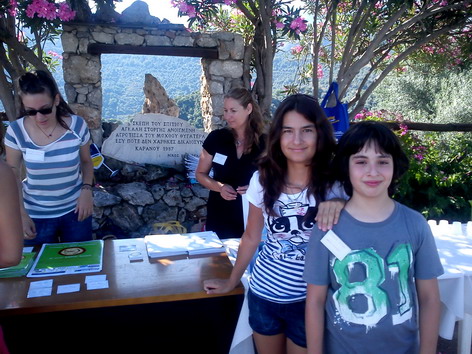
Maria Stavrianoudaki.
Assistants: Μarilena Pantelaki, Giorgos Pantelakis, Anna Georgiou, Orfeas Dialinos.
TRANSLATORS:
Maria Verivaki (photo: Uta Wagner)
Αnaya Sarpaki. (photo: Kyrstyn Kralovec)
INTERPRETERS:
Κoula Varydaki Xanialaki (photo: Kyrstyn Kralovec)
Margarita Nafpaktitou (photo: Mariana Kavroulaki)
PHOTOGRAPHERS:
POWER POINT :
Georgia Petraki (photo: Κyrstyn Kralovec)
BREAK FOOD STATION:

Debra Papadinoff (photo: Κyrstyn Kralovec)
COOKS
Eleni Michelaki, Chrysoula Providaki, Evangelia Frangedaki, Charoula Xinorodou, Εftyhia Vlahaki, Αnastasia Daskalaki, Κleianthe Pentaraki, Georgia Frangedaki, Vangelio Frangedaki, Fofo Mavridaki, Αngeliki Daskalaki, Αndriani Kotsifaki, Gregoria Mavridaki, Yiannoula Mporaki, Dina Sykiotou, Vangelio Mavridaki, Katina Providaki, Mary Kavroulaki, Μariana Kavroulaki, Τasoula Pentaraki, Anna Konstantoulaki, Εleftheria Pantelaki, Stella Konstantoulaki, Sofia Mavridaki -Pentaraki, Despoina Mavridaki, Τasoula Kalogeraki, Vasiliki Frangedaki, Antonia Frangedaki, Μaria Manolioudaki, Stella Boraki, Anna Boraki, Foteini Boraki, Κoula Varydaki- Xanialaki, Stratis Providakis.
Sofia Mavridaki, Yiannoula Boraki, Katina Providaki, Tasoula Kalogeraki, Mary Kavroulaki. (Phto: Κyrstyn Kralovec)
Κleanthe Pentaraki, Foteini Boraki, Stella Boraki, Georgia Frangedaki (Φωτο: Kyrstyn Κralovec)
Stratis Providakis (Photo: Uta Wagner)
MAKING FENNEL PIES
Ιoanna Pantelaki, chef of Cretan cuisine, made wonderful fennel pies for the participants of symposium. (Photo: Kyrstyn Kralovec)
HOSPITALITY
Andreas Konstantoulakis (Photo: Giorgos Detsis)
SYMPOSIUM BUS DRIVER
Vasilis Manioloudakis
TRANSPORTATION & DISTRIBUTION OF VARIOUS THINGS
Ιakovos Georgiou, Maria Verivaki, Philippos Exadaktylos, Babis Mavridakis
VARIOUS OTHER JOBS
Almost the whole village took part in dining services, cleaning, maintenance of conference room and other jobs.
THE MENU
SATURDAY
(photos: Kyrstyn Kralovec)
BRUNCH BUFFET
Orange juice Viochym -Creta Fresh
Homemade lemonade made by Anaya Sarpaki
Homemade lemonade flavored with lemon scented verbena, made by Fusun Ertug
Cold Cretan mountain tea [malotira (Sideritis syriaca), marjoram and sage] made by Sofia Mavridaki
Traditional cookies and small sweet rusks
Rusks made with wheat or /and barley flour. Various crispy bread sticks
Salami and smoked pork leg
Graviera cheese from Omalos
Olives
Tomato and cucumber
Rusk served with fava and chopped syglino (smoked pieces of pork preserved in olive oil)
Zucchini pie made by Charoula Xinorodou
Fresh xinohontros (a form of sour trahana) made by Kleanthe Pentaraki
Xerotigana (thin strips of fried dough served with honey syroup and sesame seeds)
AFTERNOON REFRESHMENTS
Soumada (almond drink) made by Vicky Koumantou
Cold Cretan mountain tea [malotira (Sideritis syriaca), marjoram and sage] made by Sofia Mavridaki
Cinnamon soft drink
Cretan raki
DINNER
Fresh xinohontros (Cretan sour trahana)
Boiled black nightshade, amaranth and zucchinis, served with olive oil and lemon juice
Amaranth leaves cooked with beans, zucchinis, potatoes, fresh tomato, onions and garlic
Eggplants cooked with cheese and xinohontro
Potatoes cooked with dried xinohontro
Artichoke hearts and broad beans in flour and lemon sauce
Chickpeas and rice
Meat and cheese pie (Kreatotourta)
The local version of zucchini pie (kolokythompoureko Karaniotiko)
Zucchini phyllo pie
Grape- leaf dolmathes
Stuffed zucchini blossoms
Small dakoi (rusks) served with grated tomato, myzithra (local fresh cheese), olives and olive oil
Baked snails and zucchinis
Snails yahni (cooked with fresh tomato and onions)
Snails in saor (hohlioi boubouristoi)
Dried broad beans yahni (cooked with fresh tomato and onions)
Chestnuts and potatoes stifado
Apaki (vinegar cured and smoked pork meat) cooked in orange juice
Lamb with spiny chickory
Kalitsounia (small pies with various fillings)
Fennel pies
Homemade brea
Fried bread sprinkled with honey and sesame seeds
Xerotigana
SUNDAY
(photos: Uta Wagner)
DINNER
Stuffed zucchini blossoms
Small pies stuffed with greens and cheese
Fava made with fresh beans and garlic
Lentils and bulgur flavored with parsley and cumin and served with syglino
Salad made with tomato, cucumber, green pepper and white cheese
Lamb and Chaniotiko pilafi
Kid cooked with olive oil and lemon juice
Graviera cheese served with thyme honey
The dinners were accompanied by Douloufakis Enotria White and Red Wine and Manousakis Nostos Βlend and Roussanne Wine.
Many thanks to both wineries for their kind offer.
SPONSORS
Transportation Sponsor
Communication sponsors
Product sponsors
The 1st Symposium is kindly supported by the Karanou Cultural Association “Riza”, the “Karanou” Cultural Association of Attica and the people of Karanou.
It is also supported and co-funded by the Municipality of Platanias and the Gastronomy Routes and Culture of Flavors Network under AXIS 4: Implementation of LEADER Approach of the Rural Development Programme of Greece 2007-2013.

